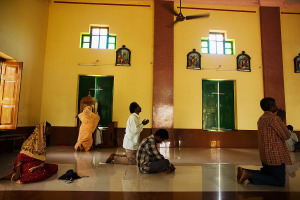The Continuing Evolution of the Digital Church

Although snow is burying cities from Nantucket, Massachusetts, to Nashville, Tennessee, many churches are finding ways to connect to their congregations through technology. According to The Boston Globe, those who could not attend services during the latest snowfalls were able to avoid isolation through live-streamed sermons, posted prayers via Facebook and emailed hymns and readings ahead of time so people could worship at home. Congregants responded by posting pictures of worshiping in their homes and messaging friends who also could not attend.
Outreach to members is not the only way churches are embracing technology. Congregations are also using social media for outreach and evangelistic efforts. One survey done by ROAR, a religious social media organization, said 98 percent of the churches it polled use Facebook, and 77 percent use Twitter. Blogs, Instagram, Pinterest and Google+ are less popular, but are still used by some churches. This shows that more people are communicating and discussing their faith online.
Leading pastors and even everyday ministry leaders have Twitter, Instagram and Facebook followers. These advancements — eagerly embraced by the church — mean the message of the church is passing far outside the four walls of the building.
Churches also have embraced the diversity and appeal of a multimedia approach to worship services. At first, congregations were tepid in their use of multiple screens, graphics, sound amplification and other media innovations. Today, however, walk into almost any neighborhood church, and you'll witness myriad adaptations of multiple media that enhance worship services. At least one-third of all churches use video clips during the worship service. More than a third use PowerPoint or similar presentation software during worship, according to business software company Capterra.
The embrace of multimedia platforms allows churches to communicate with a broader and more diverse audience than before. It also allows for a diversity of responses from churchgoers who come from different backgrounds.
Electronic giving is also on the rise. More than half of all Protestant churches with an average worship attendance of 500 or more offer online giving. As the use of checks and cash continues to decline, churches have adopted online giving platforms for their members.
Worshippers now have a variety of ways to contribute to their congregations — from donations through the church's website, to automatic withdrawals from their banking accounts, to other ways that seamlessly mesh giving with technology. At one church in Tampa, Florida, 60 to 75 percent of congregational giving is done through online billing or PayPal. Millennials also tend to give more if they have the opportunity to donate through electronics.
The increase in electronic giving and online record keeping also has forced churches to upgrade their security systems. For example, First Presbyterian Church of Birmingham, Michigan, was a victim of the latest trend in cybercrime —- ransomware attacks — which "took hostage" the main server that houses all church records and staff files. Luckily, the church was protected against the attack and was able to save its records. Reports of data breaches and identify theft are regularly in the news, and online thieves typically target those with security lapses or holes in their systems. The sophistication of these crimes means churches must now be better equipped to handle the challenges of the online world.
Tech companies are increasingly helping churches obtain the tools they need to increase their effectiveness and reach within their communities. At TechSoup, since major technology companies have recently expanded their eligibility rules for donations, we can now offer more donated desktop and office software —- such as Microsoft, Intuit and Bitdefender —- to more recipients. This means a broad spectrum of U.S. churches and other religious organizations are now eligible.
Last year alone, TechSoup distributed $37 million worth of technology products to nearly 10,000 churches and religious organizations. With the expansion of the eligibility rules, we hope to equip even more churches and parachurch ministries to meet the technology challenges of operating in today's multifaceted world.
The process is simple. If your church or faith-based nonprofit is interested in learning more about the program, you can visit www.techsoup.org/religious-organizations for a list of products and information on how to sign up.
The digital church is poised to make a significant impact on our world. By embracing technology and utilizing the latest in computer software, a church's impact on its community can increase 10 times over.




























